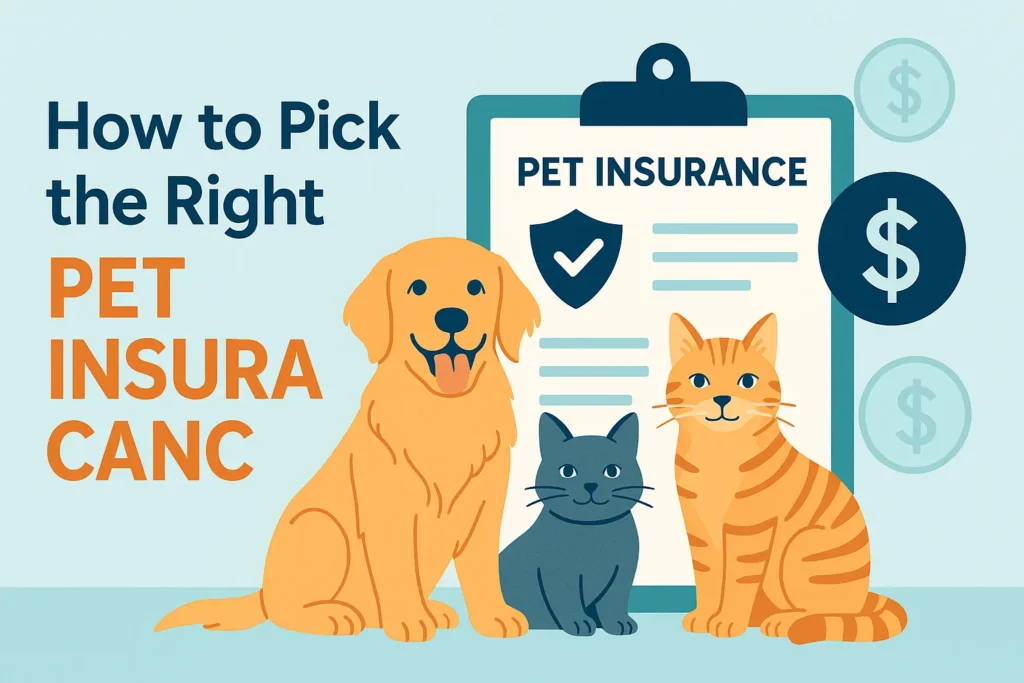How to Pick the Right Pet Insurance Plan (U.S. Guide 2025)
Are skyrocketing vet bills keeping you up at night? Pet insurance plans can rescue your budget—but only if you choose the right coverage from the start. In this step-by-step guide, you’ll learn how to compare pet insurance like a pro, avoid hidden exclusions, and lock in affordable premiums for years to come.
Table of Contents
- Why Comparison Shopping Matters
- Know Your Pet’s Risk Profile
- Coverage Types Explained
- Price Drivers: Premiums, Deductibles & Reimbursement
- Reading the Fine Print
- 5-Point Checklist to Pick the Right Plan
- Real-World Cost Scenarios
- Frequently Asked Questions
Why Comparison Shopping Matters
Fun fact: U.S. pet owners who obtain at least three quotes save an average of 27 % on premiums over the policy’s first three years.
Each insurer uses its own actuarial model, so two “similar” pet insurance plans may differ by hundreds of dollars per year—even for the same dog in the same ZIP code. Comparison shopping isn’t optional; it’s the single most effective way to keep lifetime costs low.
Know Your Pet’s Risk Profile
Before you even open a quote form, list the factors that influence medical risk:
| Factor | Why It Matters | Example |
|---|---|---|
| Breed | Purebreds often face hereditary issues. | French Bulldogs: brachycephalic airway syndrome |
| Age | Older pets claim more; premiums rise annually. | A 9-year-old German Shepherd can cost 2-3× a 2-year-old. |
| Lifestyle | Outdoor cats & adventure dogs face more accidents. | Hiking dogs: rattlesnake bites, ligament tears |
| Region | Vet fees vary by state & city. | Manhattan ER visit > Dallas ER visit |
Write these down—they’ll guide your benefit choices.
Coverage Types Explained
| Coverage Level | What’s Included | Who It Fits |
|---|---|---|
| Accident-Only | Broken bones, cuts, toxic ingestions | Young, healthy pets with tight budgets |
| Accident & Illness (Standard) | Accidents plus cancer, diabetes, infections | Most U.S. pet owners |
| Accident, Illness & Wellness | All above plus vaccines, dental cleanings, flea meds | Owners who prefer predictable monthly costs |
| Comprehensive / Unlimited | No annual cap, often includes rehab & alternative care | Breeds prone to costly chronic issues |
Pro tip: For high-risk breeds (Bulldogs, Maine Coons), comprehensive coverage usually pays for itself after one major claim.
Price Drivers: Premiums, Deductibles & Reimbursement
1. Premium
Your monthly subscription. Influenced by age, breed, ZIP code, and coverage level.
2. Deductible
The amount you pay per year (annual deductible) or per incident before reimbursement kicks in.
Rule of thumb: Choose a deductible you can cover in cash today—typically $250–$500.
3. Reimbursement Rate
Percent of the vet bill the insurer repays after deductible. Most U.S. pet insurance plans offer 70 %, 80 %, or 90 %.
4. Annual Limit
The maximum payout each policy year. Anything below $10 k risks under-insurance; unlimited is ideal if affordable.
Reading the Fine Print
- Waiting Periods – Standard: 14 days illness, 2 days accident. Knee injuries often have separate 6-month waits.
- Bilateral Conditions – If one ACL ruptures pre-policy, the other knee may be excluded forever.
- Exam Fees – Some insurers exclude the $80–$120 consultation fee.
- Alternative Therapies – Acupuncture, hydrotherapy, or stem-cell might need a rider.
- Claim Deadlines – File within 90 days (varies). Miss it, lose reimbursement.
Never assume coverage—confirm it in writing or chat with support before paying your first premium.
5-Point Checklist to Pick the Right Plan
- Collect Three Quotes using identical pet data and coverage settings.
- Sort by Annual Cost over a 5-year horizon—not just the first-year premium.
- Verify Major Exclusions (knees, hereditary, dental).
- Check Direct-Pay Availability in your primary vet clinic.
- Lock In Early—premiums soar 12 %–20 % per birthday on average.
Download our free Pet Insurance Comparison Sheet to track quotes side-by-side.
Real-World Cost Scenarios
| Medical Event | Average U.S. Bill | 80 % Plan w/ $500 Deductible | Out-of-Pocket |
|---|---|---|---|
| TPLO knee surgery | $4,800 | $3,440 reimbursed | $1,360 |
| Cat urinary blockage | $2,100 | $1,280 reimbursed | $820 |
| Rattlesnake antivenom | $1,600 | $880 reimbursed | $720 |
Without insurance, any one of these can derail a household budget—or worse, force an economic euthanasia decision.
Frequently Asked Questions
Is it cheaper to self-fund instead of buying insurance?
Only if you can consistently set aside $100+ per month and never withdraw it for 3–5 years—few owners do.
Can I change plans later?
Yes, but new policies treat prior diagnoses as pre-existing, so chronic conditions lose coverage. Choose wisely now.
Do all vets accept pet insurance?
Pet insurance in the U.S. is reimbursement-based, so you can visit any licensed veterinarian nationwide.
Final Takeaway
Choosing between multiple pet insurance plans can feel intimidating, but armed with clear cost data, a keen eye for exclusions, and the five-point checklist above, you’ll secure coverage that keeps both your pet and your wallet healthy for the long haul.
Ready to compare quotes? Jump over to our Comparison Tool—it’s free and takes under two minutes.
All statistics updated May 11 2025. Sources: North American Pet Health Insurance Association, American Veterinary Medical Association.

